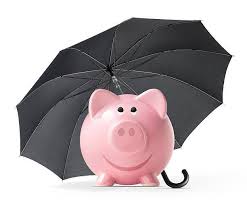A rainy day fund is another name for an emergency fund which helps you plan ahead and deal with unforeseen emergencies. Unforeseen emergencies will invariably come your way at some point. An emergency is a major and sudden need that’s not part of your current budget and that’s unplanned like a job loss, illness, an unexpected medical or dental bill or an auto or home repair. An emergency fund will help reduce stress and additional expense when an emergency arises by helping you avoid funding it by accessing longer-term savings or a high interest rate credit card.
Canadians don’t have enough set aside for rainy days
In a random survey taken by The Forum Poll™ of 1350 Canadians recently, more than half were concerned about a negative impact on their finances from the recent increase in the prime interest rate by the Bank of Canada. The same survey showed that 26% of those Canadians had no emergency savings. 9% of those surveyed said they had more than nothing but less than a month of savings. Only 28% of those surveyed had 6 months or more of savings set aside for an emergency. Another survey by CIBC reported that 53% of Canadians surveyed would need to use credit or borrow from friends and family if they were faced with an unexpected $1,000 expense. So clearly, Canadians need to set more aside for an emergency. But how much? We financial planners recommend you set aside the equivalent of 3-6 months of living expenses for unexpected emergencies. Those with larger monthly expenses will need to set aside a larger safety net. Having one month set aside is not nearly enough whereas having 12 months is most likely more than enough.
Where to save your rainy day fund
Keeping your emergency savings out of your immediate reach will help you avoid the risk of spending it for a non-emergency. Having said that. there is no use saving for a rainy day if you can’t access your rainy day fund in a hurry so it’s important that it be secure and easily accessible. You can certainly save for a rainy day in a savings account or non-registered account but tax will apply to any earnings. A better choice is saving in a Tax Free Savings Account (TFSA) also known as a Totally Fantastic Savings Account. A TFSA works well for both short or longer term savings. Contributions are not tax deductible but savings will grow faster when held in a TFSA as earnings are not taxed in a TFSA. Withdrawals from a TFSA can be made at any time for any purpose on a tax free basis. Investments eligible for a TFSA are the same as those for RRSPs: interest earning savings, GICs, mutual funds, bonds or publicly held securities. All Canadians over the age of 18 at any income level are eligible to open a TFSA. Since withdrawals are not considered to be income, they also do not impact eligibility income tested federal benefits like OAS or the GST HST credit.
Let’s get started
While it may seem like a daunting task to put aside a rainy day account equivalent to 6 months of living expenses, the key is to get started. Paying your (future) self-first really works and that’s made easy by setting aside money automatically by way of a pre-authorized contribution plan. Start with a realistic amount and automate it. Increase the amount when you can or when you receive a pay increase. Let’s chat.







